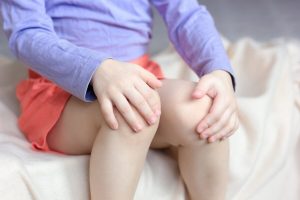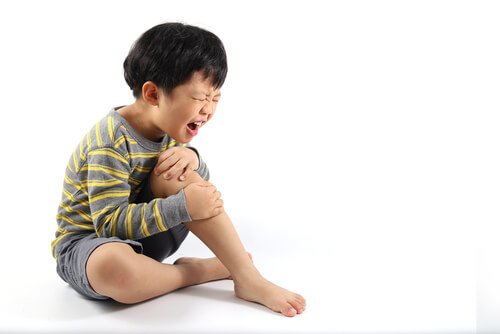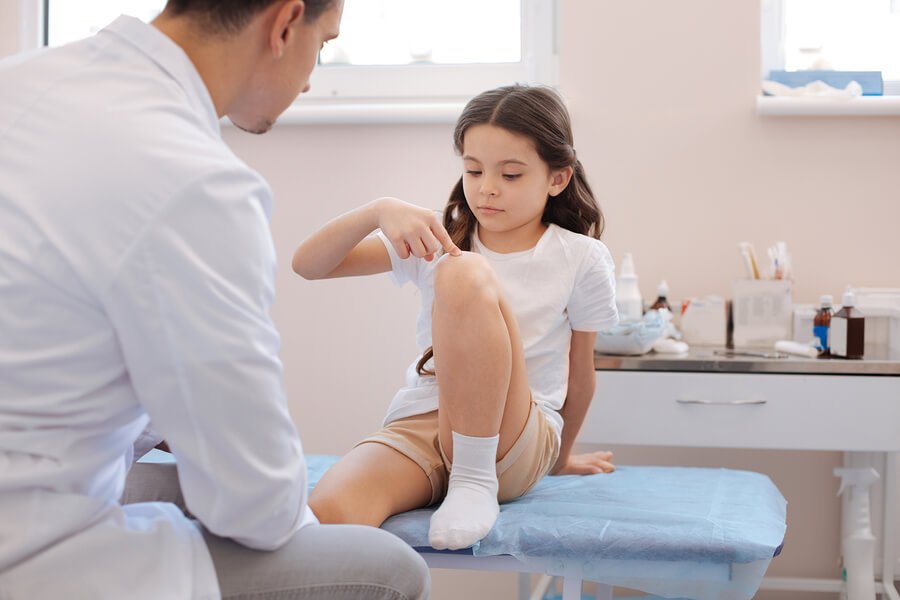What Are Growing Pains in Children and Adolescents?

Growing pains are very common in children and teens during their development. They might feel discomfort in the arms, legs, and extremities. They often complain that they feel a burning sensation.
Normally, this type of pain occurs at night. Sometimes they can even make your children wake up from discomfort.
However, you should know that they can also occur during the day. They usually don’t cause enough problems to affect daily activities.
We don’t know exactly what the main causes are. However, there are several theories. For example, many children with growing pains tend to be very flexible or have flat feet.
In most cases, pain or discomfort tends to appear and disappear. It’s difficult to guess when growing pains will occur.
If they feel uncomfortable, children usually want you to massage the painful area. This will also help you notice the difference between growing pains and serious conditions related to their bones or muscles.
Children who experience more severe pain usually don’t let anyone touch that area. If you’re worried your child has a serious problem, consult your doctor right away.

Consequences of growing pains
Mainly, growing pains occur in the legs, shins, calves, behind the knees or thighs. They can affect both sides of the body.
However, you need to remain calm. Although your children may feel a lot of pain, there’s no damage to their bones and muscles. There are simple ways to treat growing pains.
Also, keep in mind that pain may appear during the day or night. The duration of the discomfort is usually 10 to 30 minutes. However, it can range from minutes to hours.
As for the degree of pain, it can be very mild or severe. Growing pains are intermittent. Kids can go without growing pains for days or months. On the other hand, some kids may experience them every day.
If you want to reduce the amount of pain your children feel, reassure them that the pain will go away. It isn’t permanent. At the same time, massage them with special oils. This can help relieve some pain and make them feel better.
“Growing pains are intermittent. Kids can go without growing pains for days or months. On the other hand, some kids may experience them every day.”
Symptoms of growing pains in children and adolescents
Here are the symptoms of growing pains in children and adolescents. If you recognize any in your children, keep in mind that it could potentially be due to growing pains.
- Muscle aches in both legs, usually their calves, behind their knees and in front of their thighs.
- Moving their legs doesn’t improve or worsen the pain. This shows that there isn’t a problem with their joints.

- The pain appears and disappears. It worsens at night and may be gone in the morning.
- The discomfort is intense enough to wake them up.
- They feel pain in arm muscles as well.
- They may also complain of headaches.
- The pain doesn’t cause lameness. It doesn’t affect the ability to carry out daily routines.
Finally, remember that the cause of growing pains isn’t entirely clear. In fact, it’s often incorrectly thought to be caused by growing bones.
However, bones grow slowly, even during periods of accelerated development. This gradual growth doesn’t cause pain.
Some children have growing pains intermittently for many years. The good news is that, in general, they disappear in mid-adolescence.
Growing pains are very common in children and teens during their development. They might feel discomfort in the arms, legs, and extremities. They often complain that they feel a burning sensation.
Normally, this type of pain occurs at night. Sometimes they can even make your children wake up from discomfort.
However, you should know that they can also occur during the day. They usually don’t cause enough problems to affect daily activities.
We don’t know exactly what the main causes are. However, there are several theories. For example, many children with growing pains tend to be very flexible or have flat feet.
In most cases, pain or discomfort tends to appear and disappear. It’s difficult to guess when growing pains will occur.
If they feel uncomfortable, children usually want you to massage the painful area. This will also help you notice the difference between growing pains and serious conditions related to their bones or muscles.
Children who experience more severe pain usually don’t let anyone touch that area. If you’re worried your child has a serious problem, consult your doctor right away.

Consequences of growing pains
Mainly, growing pains occur in the legs, shins, calves, behind the knees or thighs. They can affect both sides of the body.
However, you need to remain calm. Although your children may feel a lot of pain, there’s no damage to their bones and muscles. There are simple ways to treat growing pains.
Also, keep in mind that pain may appear during the day or night. The duration of the discomfort is usually 10 to 30 minutes. However, it can range from minutes to hours.
As for the degree of pain, it can be very mild or severe. Growing pains are intermittent. Kids can go without growing pains for days or months. On the other hand, some kids may experience them every day.
If you want to reduce the amount of pain your children feel, reassure them that the pain will go away. It isn’t permanent. At the same time, massage them with special oils. This can help relieve some pain and make them feel better.
“Growing pains are intermittent. Kids can go without growing pains for days or months. On the other hand, some kids may experience them every day.”
Symptoms of growing pains in children and adolescents
Here are the symptoms of growing pains in children and adolescents. If you recognize any in your children, keep in mind that it could potentially be due to growing pains.
- Muscle aches in both legs, usually their calves, behind their knees and in front of their thighs.
- Moving their legs doesn’t improve or worsen the pain. This shows that there isn’t a problem with their joints.

- The pain appears and disappears. It worsens at night and may be gone in the morning.
- The discomfort is intense enough to wake them up.
- They feel pain in arm muscles as well.
- They may also complain of headaches.
- The pain doesn’t cause lameness. It doesn’t affect the ability to carry out daily routines.
Finally, remember that the cause of growing pains isn’t entirely clear. In fact, it’s often incorrectly thought to be caused by growing bones.
However, bones grow slowly, even during periods of accelerated development. This gradual growth doesn’t cause pain.
Some children have growing pains intermittently for many years. The good news is that, in general, they disappear in mid-adolescence.
This text is provided for informational purposes only and does not replace consultation with a professional. If in doubt, consult your specialist.








